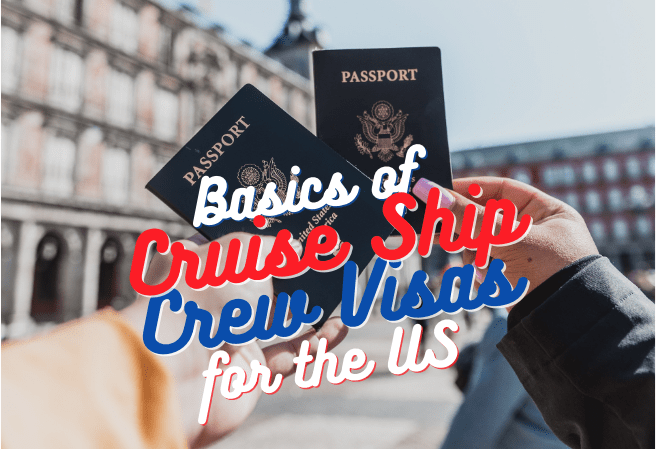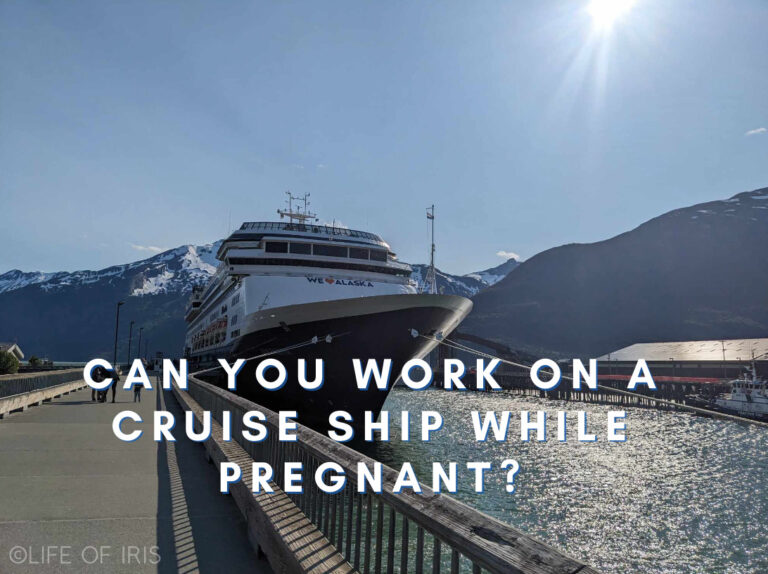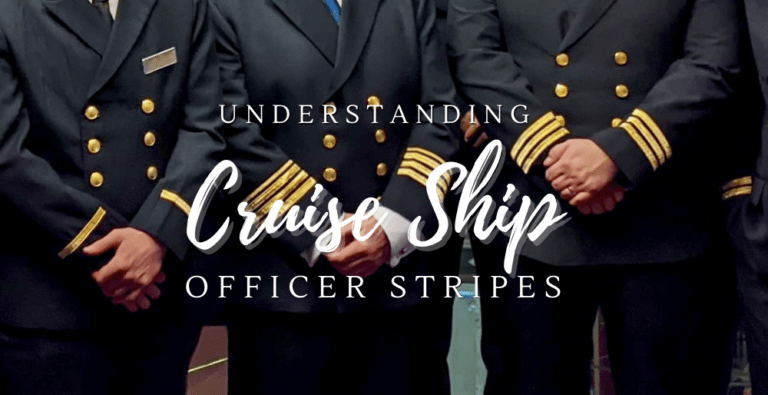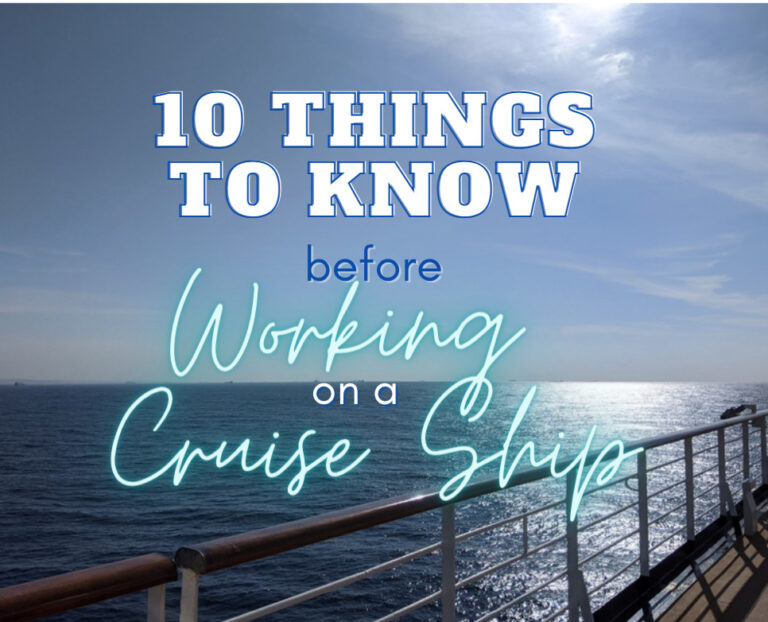Basics of Cruise Ship Crew Visas for the US
I didn’t have to worry too much about visas for a good chunk of my life. Most of my international travel was to Europe and borders were pretty freely open to US citizens. Travel to the Caribbean or Mexico was the same and I remained ignorant of the massive complexities of visas around the world. There are far more visas than I can talk about here, so for today we are going to talk about the basics of cruise ship crew visas for the US that non-US crew will end up needing and/or dealing with.
When I was working on cruise ships, specifically ones that went in and out of the United States and/or transited the United States I was largely exempt from dealing with these visa restrictions as I had a US passport that covered it. If you weren’t from the US there were a couple extra things you had to deal with. Here are the basics:
Disclosure: This is meant for general informational purposes only. I am not an attorney. This is not intended to offer guidance and/or act as any form of advice for those seeking to work on cruise ships and/or US visas to work on cruise ships. If you have a contract that will require you to enter the United States please contact either your employment agency or cruise company for information regarding your visa requirements and procedures. More information can also be found on the travel.state.gov website.
Flying Into the US
Crew members can come and go into the US on their appropriate visas. In fact, these types of visas are currently in the exempt category under the Presidential Proclamations restricting travel.
The C-1/D
A C-1/D visa is a combination visa that both allows the transit into the United States to the cruise ship from the airport as well as to work on the ship. This visa goes into your passport and is usually issued for ten years. This particular combination visa is the most need to know of the basics of cruise ship crew member visas for the US. It is absolutely essential for non-US crew members looking to work on a cruise ship coming and going from the United States. These visas aren’t specific to cruise ship crew and work for other jobs, such as airline personnel, for crew member and transiting purposes. The transit visa portion is the “C-1” part of the nomenclature, and the “D” part is the crewmember visa.
Now, the part that specifically complicates my life is which visa you enter the United States on matters. For instance, if my husband comes to the United States to see my family and enters on an ESTA (Electronic System for Travel Authorization), which is the most basic way to visit the US as a tourist, if he then needs to join a ship that was in US waters he would have to leave the United States to then re-enter on his C-1/D visa. Luckily I am from Vermont, and so in normal non-COVID times we can do a short drive to the airport in Montreal for him to fly out of.
There is a section that could cause some confusion: “Crewmember (D) visas are nonimmigrant visas for persons working on board commercial sea vessels or international airlines in the United States, providing services required for normal operation and intending to depart the United States on the same vessel or any other vessel within 29 days.” (from travel.state.gov website) This could make you think there was some leeway with when you joined the vessel versus when you landed in the United States, but it also states in the Travel purposes not permitted section: “A foreign citizen whose layover in the United States is for a primary purpose other than to transit, for example to visit friends or sightsee”. My understanding of this is for instance if you work for an airline and you flew in but your next flight wasn’t for a few days you would be covered.
Getting Off the Ship In the US
I was watching a popular cruise YouTube channel the other day when a former crew member said that he (as a US citizen) would go ashore in US ports to buy things for crew members that weren’t allowed to disembark. It’s possible that the ship he was on might have had a poor history of people abandoning their passport and ship and entering the US illegally (this does happen, although I never saw it happen as much as he insinuated) and thus Customs and Border Patrol might have put increased restrictions on it. It’s also possible that he wasn’t familiar with the various additional paperwork and procedures that might limit someone’s ability to go ashore in US ports.
The I-95
No, in this case I am not talking about the interstate, nor the very busy crew hallway. I am instead talking about a Crewman’s Landing Permit. For a non-US crew member this is a physical piece of paper that you get that you both need to be able to go ashore and have to have with you while ashore in US ports. You also can’t go ashore in US ports until you have it and Customs and Border Patrol people typically only issue it at one port each cruise (most often a home port) or in the case of cruises out of a place like Vancouver, likely in Juneau.
What does all that mean? Well, say you join a cruise ship in San Diego, the ship then sails out to Hawaii, four sea days out, four or five days on the islands, and then four or so days back. Before heading to San Diego it will likely stop in a place like Ensenada, Mexico because of The Jones Act.
When the ship arrives back in San Diego first thing in the morning all newly embarked crew will meet with a Customs and Border Control Agent. (This includes US citizens.) They will check your passports and various visas. If you aren’t from the United States then you will be issued an I-95 landing permit. At this point you are now legal to get off the ship to go ashore in the United States. Yay!
Yes, that means that if you aren’t from the United States and you join a ship in the US you will likely go one cruise where you cannot disembark and visit the US ports on that cruise. So, that above mentioned Hawaii cruise? Why yes, you would be on the ship, looking in the distance at the beaches thinking to yourself, “doesn’t that look nice”.
Doing Work-Like Things Ashore
There have been a few times while working onboard that my value as a US citizen was helpful. This isn’t a situation where there are any particular visas to get but rather simply interesting anecdotes.
The first and most notable was one year when the ship I was on visited Sitka, Alaska. In Sitka at the time there wasn’t a dock and we had to tender in. When you tender there needs to be people at the dock to tie the tenders off. This had previously been done by the longshoreman that work for the company; however, none of them were US citizens. While I don’t remember the exact specifics of why – something to do with the local unions in Sitka – the longshoreman for the company were no longer allowed to tie off the boats. The company could either use the local longshoreman or crew members that were legally allowed to work in the US. Enter me, full khakis, safety shoes, safety vest, and rain suit on several very rainy days acting as a longshoreman. Why yes, I got paid extra, and why yes, it was most definitely worth it.
Did you know that if the ship needs certain supplies ashore (that aren’t purchased through the usual means), that they will send a US crew member or Green Card holder ashore to get it? That’s because sometimes making purchases ashore is considered work and thus if someone not legal to work in the United States makes the purchase it could be against US labor and immigration laws. Read: doing work in the United States without the proper visa. Go figure.
It’s Not Just the United States
It is most certainly not just the United States that have various visa requirements and restrictions for crew members. However, as (during normal times) there is such a large cruise industry in the United States and so many crew members are affected by this I thought this would be a great one to shed light on. Also, maybe inform that YouTuber why some crew members can’t get off the ship every week in New York. Hopefully you’ve learned a bit about the basics of cruise ship crew visas for the US.
More questions about crew life, what to expect, and what you need? Take a look at our page all about what it’s like working on a cruise ship.







